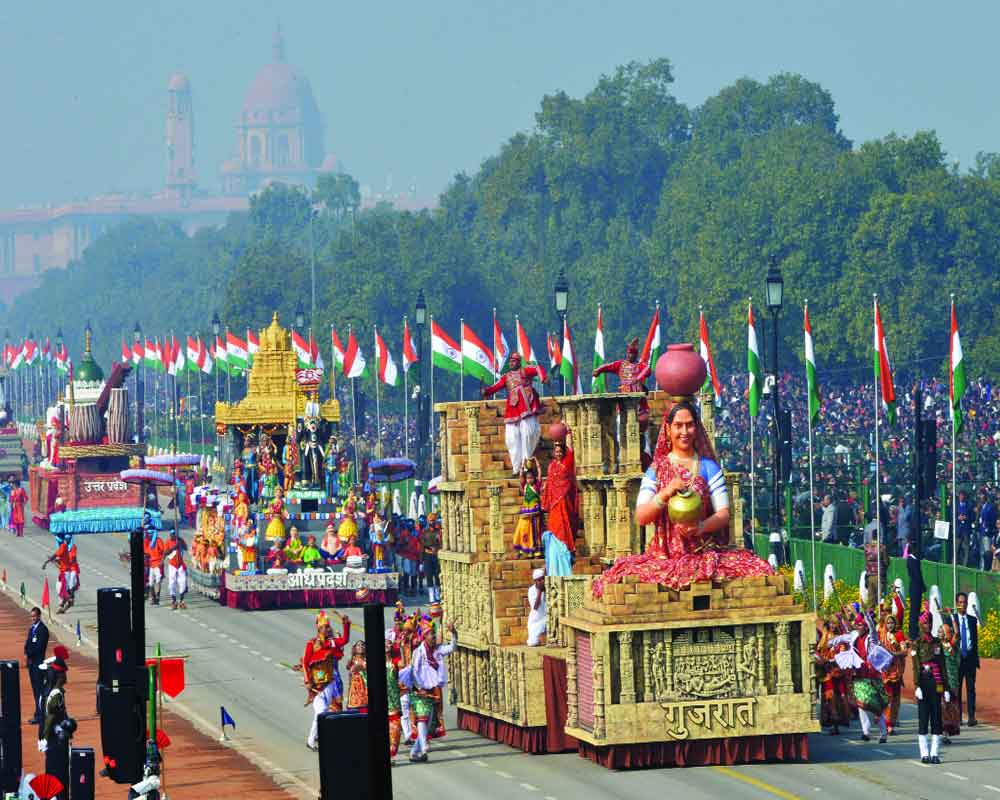In a first, the PM pays tributes to martyrs at National War Memorial
Majestic Rajpath reverberated with clap as contingents and tableaux marched on Sunday with the nation celebrating the 71st Republic Day. The parade saw India showcasing its military might with strategic weaponry and exhibition of its history and its rich cultural diversity.
Brazilian President Jair Messias Bolsonaro, who was the chief guest for this year’s ceremony, watched the dazzling parade at the historic avenue in the national capital as President Ram Nath Kovind took the salute, with Prime Minister Narendra Modi, Vice President Venkaiah Naidu and a host of other leaders in attendance.
This was the third time that a Brazilian President was the Chief Guest at the Republic Day.
There were several firsts in the celebration this year, including the PM paying homage at the National War Memorial, display of Chinook and Apache helicopters in the fly past and showcasing of the A-SAT weapons system.
The band played the national anthem with a 21-gun salute in the background when the Tricolour was being unfurled at the Rajpath before the start of parade. Earlier in the day, Modi took to Twitter to extend his greetings to countrymen. “Wishing everyone a happy #RepublicDay. Jai Hind,” he tweeted. After Republic Day parade, he waved at the cheering crowd while walked on the Rajpath.
Twenty-two tableaux were on display during the parade, of which 16 were of various States and UTs and six were of Ministries, departments and the National Disaster Response Force (NDRF).
Jammu & Kashmir, which participated in the parade for the first time as a Union Territory, had the “Back to Village’’ programme as the theme for its tableau.
While Goa’s tableau highlighted its biodiversity and “save the frog”, its anti-frog poaching campaign, Indian Air Force’s tableau was a scaled down model of Rafale aircraft, Tejas aircraft, Light Combat Helicopters, Akash Missiles System, and Astra Missiles against a sky blue background.
The tableau of the Ministry of Jal Shakti showcased Government’s new initiative “Jal Jeevan Mission” which aims to provide a functional tap connection to every rural household by 2024.
The National Disaster Response Force’s tableau showcased the cutting-edge technology used by the agency during rescue operations in flood-hit areas and Delhi’s Anaj Mandi inferno last year.
The “Dhanush” gun system, commanded by Captain Mrigank Bharadwaj, was part of the celebrations for the first time on Sunday. The gun with a maximum range of 36.5 km has the capability of automatic gun alignment and positioning. Helicopters Chinook and Apache, both recently inducted in the Indian Air Force, also took part in the flypast for the first time.
The Chinooks can airlift diverse loads in remote locations. It is a heavy lift, twin rotor helicopter which has enhanced IAF’s lift capability across a range of military and HADR missions.
The Apache, on the other hand, is a versatile helicopter capable of firing air to air and air to ground missiles, rockets and front gun aided through fire control radar which can unleash havoc on the adversary.
Captain Tania Shergill, a fourth generation Army officer, led the marching contingent of the Corps of Signals. Keeping up with the pace of technical advancement in the 21th Century, the Corps of Signals has effectively achieved electronic and information superiority to empower the Indian Army against adversaries.
Earlier, Prime Minister Narendra Modi on Sunday paid homage to the fallen soldiers at the newly-built National War Memorial here on the Republic Day for the first time instead of the Amar Jawan Jyoti beneath the India Gate arch. The iconic memorial in the India Gate complex behind the canopy was inaugurated by Prime Minister Narendra Modi on February 25 last year.
Amar Jawan Jyoti is symbolised by an inverted bayonet and soldier’s helmet over it with an eternal flame burning beside it. It was built in 1972 underneath the India Gate arch to commemorate soldiers martyred in the Indo-Pak War of 1971.
Spread over an area of approximately 40 acres, National War Memorial comprises four concentric circles, namely — the “Amar Chakra”, “Veerta Chakra”, “Tyag Chakra” and the ‘Rakshak Chakra’ with names of 25,942 soldiers inscribed in golden letters on granite tablets.
It also includes a central 15.5-m obelisk, an eternal flame and six bronze murals depicting famous battles fought by the Indian Army, Air Force and the Navy in a covered gallery (Veerta Chakra).
The memorial is dedicated to soldiers killed during the Indo-China War in 1962, Indo-Pak Wars in 1947, 1965 and 1971, Indian Peace Keeping Force Operations in Sri Lanka and in the Kargil Conflict in 1999, and also those in the UN peacekeeping missions.
The 42 m-high India Gate was built during the British Raj as the All India War Memorial Arch to honour the soldiers who died in the First World War (1914-1918) and the Third Anglo-Afghan War (1919). The landmark has the names of soldiers inscribed on its surface.
Home Minister Amit Shah, Defence Minister Rajnath Singh, External Affairs Minister S Jaishankar, former Prime Minister Manmohan Singh, Congress president Sonia Gandhi and Delhi Chief Minister Arvind Kejriwal were among those who attended the celebrations.


























